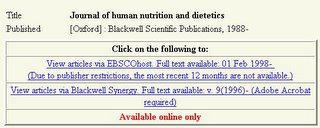
John Redmayne, University Librarian, has given us an outline of the Library's direction in the coming year -
Budget
The Library has received notice of its capital grant for the year (which pays for our books and journals). In particular, we have been able to increase the book budget across allocations by an average 7%, which should enable us to cope with book publishers’ increases and some movement in the New Zealand dollar. The allocation for electronic databases and e-journals includes an 8% increase for publishers’ prices, and the print (paper) serials (a diminishing portion nowadays of our collections budget) still allows for a 10% increases in publishers’ costs. Of course, there is a certain nervousness about the value of the New Zealand dollar later in the year when we pay our subscription renewals. The budget includes a sum for such a contingency, and the Finance Section of the Registry also purchases forward currency for us (mostly in US dollars these days). We will continue to monitor currency movements carefully during the year, but generally the 2006 capital grant is good news for the Library, and further action will need to be taken only of the dollar drops severely.
Backfiles
At the end of 2005 we took advantage of the strong dollar to make some significant one-off purchases. For science, these included a further backfile for 1945-1969 of the Web of science (Science citation index). One further file is available (1900-1944), and a few libraries have now started to purchase. This is something we may consider in the future, if there is interest and if funding becomes available. We also purchased the archive of the Commonwealth Agricultural Bureau Indexes for 1920-1972 (to supplement our electronic file from 1973), so we now have to full set, and the printed indexes can be retired to the closed stack. Elsevier’s ScienceDirect database of full text journal articles covers issues from 1995. Over the past two years we have been buying the archives (back to the first issue of a title) for selective subject areas. In 2004 we bought the subject files for agriculture, biochemistry and molecular biology, and veterinary science. At the end of 2005 we were able to buy further subject backfiles for environmental sciences, mathematics and engineering. We have also purchased BioOne (a collection of 81 biological science titles from society publishers), with the life science developments at Albany particularly in mind, and made a major expansion of our holdings of the Nature research and review journals, so that now we have available (and electronically) all of these journals except the two drug trial titles in the Nature package.
Rodski Survey
In September 2005 the Library participated in the Rodski client satisfaction survey, and thank you to those who completed the online survey form. Rodski is an independent company, and the library survey has been completed by all of the Australian university libraries and 4 of the 8 New Zealand university libraries, so it is very useful for benchmarking, as well as for the individual results. We have over 200 pages of specific comments from Massey library users and we are working our way through these at the moment. The overall result was pleasing, with Rodski placing the library in the first quartile (top 25%) compared with the other libraries on their database. The greatest gap differential between expectation and performance was for library facilities and equipment. But in service quality, service delivery and library staff Massey ranked as well in the top 5 for the 15 Australasian university libraries who completed the survey in 2005.
Digital repository trial
In 2006, the Library will be trialling the ProQuest Digital Commons software, with some pilot projects for both digital theses and research papers, and making these available on the web. Three other New Zealand university libraries will also be trialling this software. This is the precursor to the eventual establishment of an institutional repository, which is a much larger project, and for which Massey is an international partner in the RUBRIC project with a number of Australian universities, and with Gerrit Bahlman, our ITS Director, as a Board member.
John Redmayne
University Librarian.





